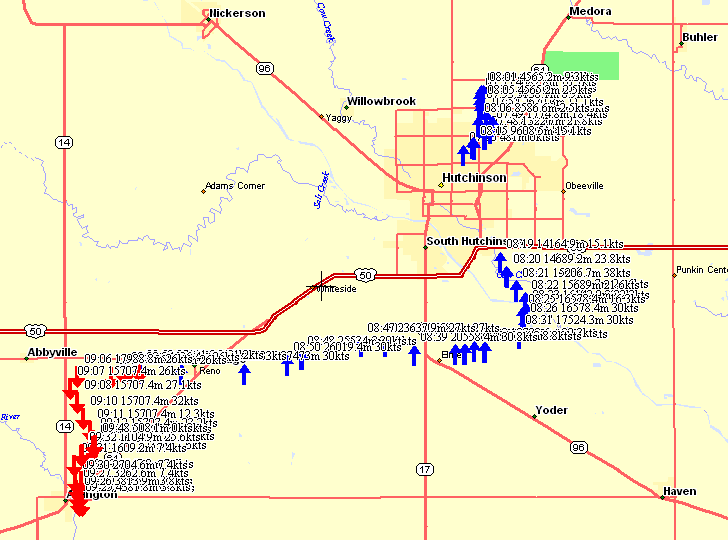Our second flight is to include an ATV transmitter to give us live video feeds from the capsule.
| Flight Parameters | |
|---|---|
| Launch Date/Time | Saturday, 4 August, 2001 at 8:00am |
| Alternative Date | Saturday, 11 August |
| Launch Site | East fairgrounds parking lot near Fairgrounds Pool (38º 04.6'N, 97º 54.9'W) in Hutchinson, KS |
| Primary Transmitter / Antenna | VX-1R HT running APRS on 144.39MHz / Vertically polarized dipole |
| Backup Transmitter / Antenna | PC Electronics 1.5W ATV Transmitter on 434.00MHz / Horizontally polarized two element yagi pointed down |
| Backup Transmitter / Antenna | Keyed oscillator on 147.55MHz (no modulation) / Horizontally polarized dipole |
| Balloon / Gas | Kaymont 1200gram / 230 cu feet of Helium |
| Estimated Burst Altitude | 78,000' MSL |
| Estimated Ascent Rate | 1300' per minute |
| Estimated Descent Rate | Approx. 1400' per minute at touchdown |
| Capsule(s) weight | 5lb 4oz (2385g) including parachute, rigging, batteries, etc... |
| Chase Frequencies | 147.12+, 146.82-, 146.52MHz, 7.2535MHz |
Flight Results
The flight #2 on 4 August, 2001 went very well overall. The ATV video was a little on the disappointing side, but hopefully we can rework that next time. I think we can keep the video live a little bit longer and I would also like to put some logic behind it so for example, the transmitter will stay on below, say 10,000' and then stay on above 70,000' (for the burst) and then be intermittent between those altitudes.
| Flight Statistics | |
|---|---|
| Launch Date/Time | Saturday, 4 August, 2001 at 7:47am |
| Launch Site | East fairgrounds parking lot near Fairgrounds Pool (38º 04.6'N, 97º 54.9'W) in Hutchinson, KS |
| Burst Altitude | 92,000' MSL |
| Average Ascent Rate | 1350' per minute |
| Measured Descent Rate | Approx. 1450' per minute at touchdown |
| Touchdown Site | 2 miles north-northeast of Arlington, KS (37º 55.5'N, 98º 09.6'W) |
| Recovery Time | Saturday, 4 August, 2001 at 9:48am |
| Distance Traveled | 16 miles as the crow flies |
| Total Flight Time | 1 hour 48 minutes |
| Downloads | Lat/Lon File, Log File, Flight Analysis |

Lessons Learned
- We had a couple small ground equipment failures/problems, but they weren't anything major - we just ran out of time to get all of the bugs worked out ahead of time. I plan on starting development on a dedicated receive-only TNC that would function nicely in the chase-vehicle role. I think I can build one for under $50 (which would cut the cost in half from about anything else on the market) and would be a little more flexible and reliable.
- The ATV video was disappointing. I'm not sure if there's a whole lot that can be done but it would probably be worth trying various receive antennas (cross-polarized, beams) as well as thinking about the transmit antenna. This ATV had a 2 element yagi pointed down, however it was hastily tuned. More work could be done for a more rigid structure.
- We also had problems with the video recorders on the chase vehicles stopping about 1 hour after launch. This was probably due to bumping a button or sunlight tripping the IR sensor, but a little experimentation would be in order.
- The tailboom on this package didn't seem to have much effect on the rotation of the capsule. The launch video (ground video) of the first launch indicated that package was weather-vaning. It was evident very early on that this package was spinning right off the bat. The first time may have been a fluke, or it could be caused by the smaller, more streamlined tail fin used on this flight.
- There was a significant amount of condensation on the package upon retrieval. We loaded silica gel packets into the capsule to help reduce humidity during the descent, but it didn't have much effect. By coating the PCB board, we did prevent the transmitter from keying up though. The amount of condensation may have in part been due to the capsule housing cracking open on impact - this sudden opening of the otherwise sealed package can be clearly seen in the graphs by a very rapid increase of inside air temperature immediately after touchdown. A future experiment may be to include a humidity/condensation sensor on board.
- A time stamp needs to be included in the telemetry data to help determine when it was sent. The time can be obtained from the GPS. This will just be a simple software change.
- We have large gaps in the log files - presumably caused by other stations transmitting on the same frequency. It would be worth trying a different frequency next time to confirm that other APRS stations are the cause of data loss. On a similar note, we should ensure that none of the chase vehicles are transmitting APRS packets on the balloon frequency.
